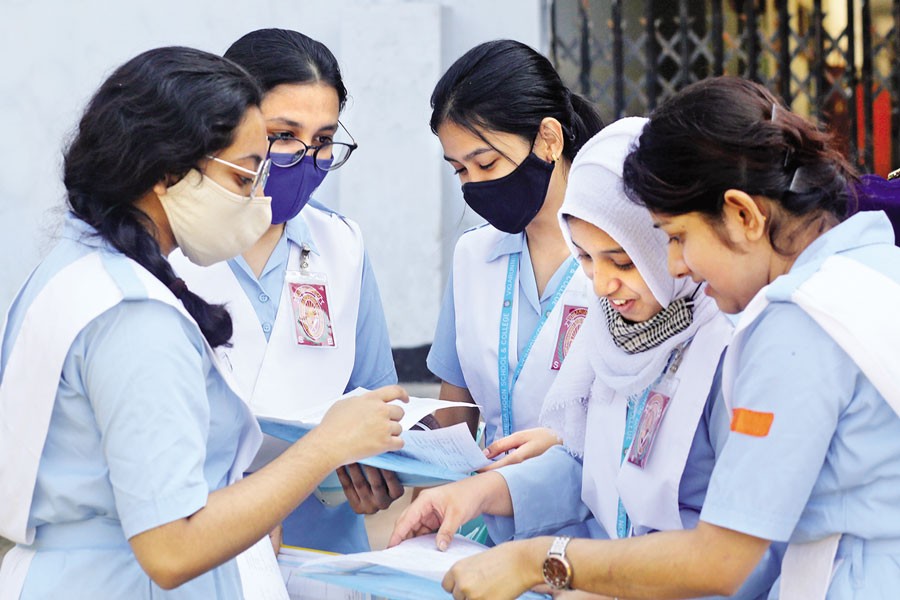
Bangladesh’s growth: Quality education remains a key factor
Mustahsin Ul Aziz | Thursday, 10 November 2022

 Hardly is it possible to overstate the role education plays in socioeconomic advances. Nelson Mandela once said, "Education is the most powerful weapon we can use to change the world." The importance and impact of education are not only limited to acquiring knowledge but also imperative for providing an important platform to climb out of poverty. Nowhere else is it more evident than in the development of Bangladesh, graduating from being a Least Developed Country (LDC).
Hardly is it possible to overstate the role education plays in socioeconomic advances. Nelson Mandela once said, "Education is the most powerful weapon we can use to change the world." The importance and impact of education are not only limited to acquiring knowledge but also imperative for providing an important platform to climb out of poverty. Nowhere else is it more evident than in the development of Bangladesh, graduating from being a Least Developed Country (LDC).
The economic development the country has achieved can be traced back to the massive development it made in the education sector. The literacy rate increased from about 62 per cent in 2007 to about 95 per cent in 2020, highlighting the gains made by Bangladesh in education.
According to UNESCO, the education system currently hosts about 58 million students enrolled across the four levels from pre-primary to tertiary education, emphasising the growing interest of people in education. Complete enrollment in primary education has been achieved, with the gross enrollment rate increasing from 52 per cent in 1971 to 112 per cent, including early and late enrollment, in 2020. Significant progress has been made in achieving gender parity with more female-to-male enrollment ratio (1.09:1.00) in 2021 compared to the ratio (0.49:1) in 1971. Lower-secondary education enrollment also improved from 55 in 2000 to about 90 per cent in 2018.
However, despite these leaps in education, there remain many underlying difficulties that the education sector needs to address, with quality education being the primary area of focus. Improvements in enrollment need to be bolstered by gains in education quality to achieve the rewards of education and maximise the benefits of the bestowed demographic dividend for the country. Bangladesh ranked 112th out of 138 countries in the Global Knowledge Index. The country's expenditure in the education sector is also falling, with only 11.7 per cent of the country's total expenditure allocated towards education, from 21 per cent in 2010.
This change in priority has affected many areas of education improvement, one such being the teachers' lack of training and development. Only 50 per cent of all primary teachers have received the minimum professional training, pre-job or on-the-job, necessary to teach. Teachers' training and professional development are vital for any education system as the students generally reflect the quality of the teachers.
According to a World Bank report, more than 50 per cent of the grade-5 students did not achieve grade-level proficiency in Bangla and Math. For grade-8 students, only 44 per cent of the students have the required English proficiency, and about 35 per cent have proficiency in mathematics. This means that a student in Bangladesh who enters the education system at age 4 and graduates secondary at the age of 18, s/he would have only 6 years of learning-adjusted years of schooling. So rather than having the competency of a person who had 12 years of schooling, they have half of that.
This is alarming as time and resources are not being utilised efficiently. This leads to lower-quality students in the tertiary sector and in turn lower-quality workforce. The impacts of COVID-19 are going to further aggravate the problems, with enrollments expected to fall and learning-adjusted years of schooling projected to fall to 5.1 years.
Despite these challenges, there remain many avenues to capitalise on. One such avenue is the development of teacher numbers and quality. Many schools, especially in rural areas, have high student-to-teacher ratios. For quality education to be imparted, teachers need to be able to take care of each individual student, which is often difficult with a class size of 45-50 students. Increasing the number of teachers can help. Alongside this, the focus needs to be given to the continuous professional development of teachers.
According to a recent study, teacher training in Bangladesh should focus on three key areas: improving professional learning, practice and engagement, and specific training content. It needs to be ensured that all the teachers receive basic pre-service training and are provided with continuous training in understanding the new emerging methods of pedagogy.
Incentives for teachers, such as awards, can also be introduced to increase teachers' motivation and recognise innovations. High-performing teachers can also be utilised to deliver national-level lessons using digital learning platforms. An existing digital learning platform like 'ShikkhokBatayon' can be utilised to share learnings and good practices. Such platforms can also be used to introduce mandatory training courses, which many institutions already use worldwide.
This digital training system will significantly reduce the resources required for teachers' training and ensure that teachers do not have to take time off during the semester to attend training, as the platform will allow teachers to complete courses at their convenience.
This brings us to the next major area of focus: increasing digital learning avenues. The onset of COVID-19 has brought about a change in the mode and delivery of education. The hybrid lecture format is already very popular in the tertiary sector, with Bangladesh Research and Education Network (BdREN) providing support to more than 8 million students since the pandemic outbreak.
However, opportunities remain to provide a high-speed internet connection to every school, especially in rural areas. On a student level, the digital infrastructure is already established, with about 97 per cent of the students having access to some remote-learning mode (computer, mobile phones, etc). Utilising this infrastructure to provide increased remote-learning opportunities to students can significantly contribute to bridging the urban-rural inequality gap, especially for students in remote and hard-to-reach areas. Existing public and private student platforms can also be utilised to make good lessons available to students across the country.
The third major focus area is to develop the technical education sector. For any developing country, the technical skills sector is crucial for continuing on the development trajectory. The provision of scholarships and stipends has increased the enrollment rate to 17 but still lags behind the target of 30-percent enrollment by 2030. In addition to increased enrollment, the quality and quantity of teachers both need to be improved, given major teacher shortages still exist in many vocational education institutions. There is also a need to introduce competency-based standards in technical education, as there remains a skills mismatch between the skills demanded by employers and the skills taught by the education centres.
Fostering partnerships between industry and academia can be of particular interest in this regard. Many successful countries with thriving technical sectors, like Singapore and South Korea, use the industry to supply new equipment to schools. In turn, schools provide the industry with skilled workers, creating a win-win situation for both and making it a viable option. It is of utmost priority to improve the technical education sector as it will not only bolster the domestic labour market but also improve the earnings of migrant workers.
Overall, many structural problems remain in the education sector, such as different education streams, proper monitoring and evaluation systems, etc. However, the progress Bangladesh has made in education is triumphant, especially considering the country's socioeconomic situation.
Yet, as we prepare to wear the mantle of a lower-middle-income country, we also have to be careful not to fall into the middle-income trap. Education, and quality education, is one of the best ways to create a skilled labour force that can sustain the country's growth trajectory.
The writer is a former education economist at The World Bank.
mustahsin.ul.aziz@gmail.com